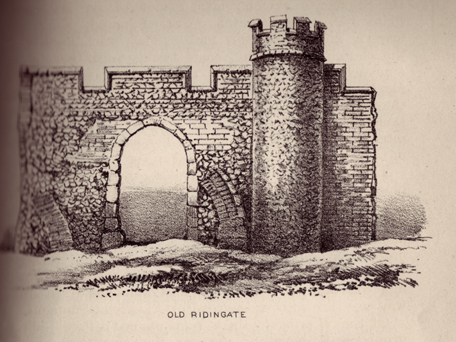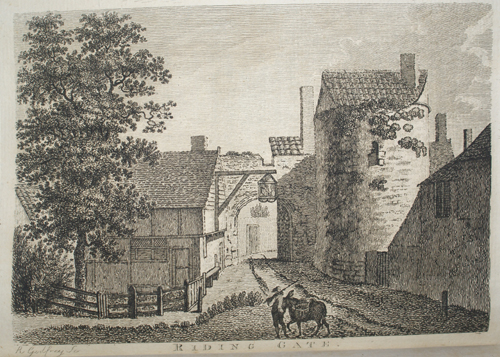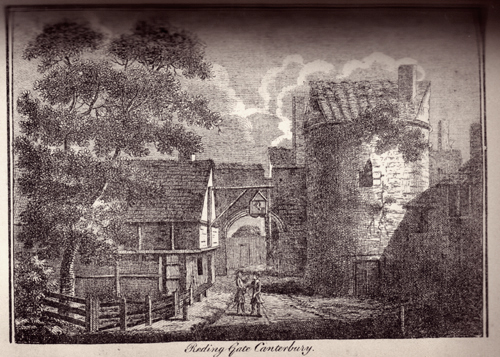
![]()
~ RIDINGATE ~
Redyngate, Road-Gate, Rider's Gate
CANTERBURY
Between Watling Street and Old Dover Road
Taken down 1782

Drawing from Canterbury in Olden Time John Brent 1879
John TERRY, carpenter, for wh. he paid his fine* in working and allowing stuff for the new making of Ridingate both the leaves therof. 1614 FOC 1903
(*to become a freeman)
"In July 1812, the iron fence on the wall leading to the Ridingate was erected. The city tower on the Dane John next to the Ridingate was removed in 1769. The gardener's cottage was erected by Alderman Simmonds in 1812. It was supplanted by a more commodious building in 1877." cot
1563. A letter is received from the Privy Council, appointing Commissioners to take a view of Ridingate, and signify to the Mayor and Aldermen, that they cause it to be widened, sufficient for carriages to go through it. HT
"...And another lease informs us that in the reign of Queen Elizabeth there was sufficient water in the city ditch between the said gates* to make it worth while to reserve the fishing rights when the Mayor and Commonalty let the adjoining land. Further we learn that at this date (1586) the Cattle Market (Retherchepe) was held in the neighbourhood of Oaten Hill." Woodruffs List
*St. George's Gate and Riding Gate
Ridingate, anciently Radingate, or Rider's Gate, was that by which lay the military road of the Romans, between Dover and this city. This gate was taken down in 1782; and in 1791 a spacious gothic arch of brick, coped with stone, was erected in its stead. 1838 directory
Ridingate Ward, so called from the ancient Gate, so named. By this gate is the Roman Portway, or Military Way between Dover and Canterbury, from which we suppose, it took its Name; for Ridingate implies nothing else, but the Road gate. By this Gate formerly stood a Church, dedicated to St. Edmund, the King and Martry, called therefore St. Edmund's at Ridingate. MBA1738
1782. Ridingate, Redyngate, or Road-gate, the oldest of all the city gates, and said to have been standing before the conquest, being in a very decayed state, is taken down. In 1791 it is rebuilt by alderman Simmons, at great expence. HT

"Riding Gate or Road Gate, led from one of the principal vias, the "Watlinga Strete" of the Saxons, towards Dover and Lympne.
It is mentioned in the Records of Saint Augustine as early as 1040, and doubtless it pointed to one of the principal modes of egress and ingress to the Roman Canterbury. Roman arches were said by Somner to have existed in the ancient fabric of this gate, which was destroyed in 1782, and in 1791 an arch was thrown over its remaining piers, making a connection with the Dane John and present terrace.
The way through the gate, passing by Barham Downs, obtained the name of "Dun Strete," or way over the Downs. It is evident that Ridingate, though presenting a very modern and mean appearance, was one of the ancient gates of the city. A.D. 1563, the Privy Council ordered this gate to be widened sufficiently for carriages to pass through. When the Ridingate was taken down in 1782, some portion seems to have remained. An archway was thrown over the road by Alderman Simmons." COT

"The other old eastern gate was further south at the end of the old Watling Street; it was on the site of one of the ancient Roman gates, and gave access to the city from the old Dover Road. It was usually called Ridingate; it was of a simple early character, and was most unfortunately cleared away as late as the "eighties" of last century." CC
"....keep still on this Watling street, and enter the city through Ridingate, after showing him that the Roman gate here had two contiguous arches, turned with the large and thin bricks of those times, remains of which are still to be seen but the ground has been so raised, that the top of a stone pier from which one of those arches sprung, is but breast high from the road, and the arch itself cut away, to give the necessary height to the present gate, of later construction.
Within it at forty feet west, on a square stone in the wall, was the date 1586, and below, the letters I.E.M. for John Easday, Mayor, whose public spirit Mr. Somner mentions very honourably for this repair in the city wall, at his great cost, though a man of indifferent estate, in hopes of setting a good example. But this hint is lately stolen away, and his example never likely to be followed. WG7

"Ridingate was anciently written Radingate, by which lay the portway or military way of the Romans, between Dover and Canterbury, the street leading along which into the city, being at this time called Watling street a name given to one of their four famous ways or streets, which crossed this kingdom. This gate, a very ordinary structure, was pulled down a few years ago, to make the opening more convenient for passengers*. The ancient Roman gate here, appears to have had two contiguous circular arches, turned with British or Roman brick of those times, remains of which were lately to be seen, though the ground had been so much raised, that a stone at the top of one of the piers, from which one of those arches sprung, was but breast high from the road, and the arch itself was in part cut away to give the necessary height to the late gate of much more modern construction.**"
*In 1790, a very spacious arch was erected and the terrace walk, formed on the rampart of the city wall, continued over it, at the sole expence of Alderman James Simmons.
**Within about 40 feet westward from Riding-gate, on a square stone in the wall, was the date 1586, and below, the letters I.E.M. for John Easday, Mayor, whose public spirit Mr. Somner mentions very honorably for this repair of the city wall at his great cost, though a man of but indifferent estate, in hopes of setting a good example; but the stone has been lately stolen away and his example is by no means likely to be followed.*HT